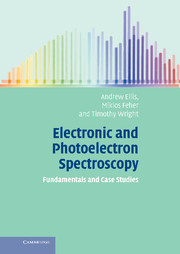Book contents
- Frontmatter
- Contents
- Preface
- List of journal abbreviations
- Part I Foundations of electronic and photoelectron spectroscopy
- Part II Experimental techniques
- Part III Case Studies
- Appendix A Units in spectroscopy
- Appendix B Electronic structure calculations
- Appendix C Coupling of angular momenta: electronic states
- Appendix D The principles of point group symmetry and group theory
- Appendix E More on electronic configurations and electronic states: degenerate orbitals and the Pauli principle
- Appendix F Nuclear spin statistics
- Appendix G Coupling of angular momenta: Hund's coupling cases
- Appendix H Computational simulation and analysis of rotational structure
- Index
- References
Appendix D - The principles of point group symmetry and group theory
Published online by Cambridge University Press: 05 June 2012
- Frontmatter
- Contents
- Preface
- List of journal abbreviations
- Part I Foundations of electronic and photoelectron spectroscopy
- Part II Experimental techniques
- Part III Case Studies
- Appendix A Units in spectroscopy
- Appendix B Electronic structure calculations
- Appendix C Coupling of angular momenta: electronic states
- Appendix D The principles of point group symmetry and group theory
- Appendix E More on electronic configurations and electronic states: degenerate orbitals and the Pauli principle
- Appendix F Nuclear spin statistics
- Appendix G Coupling of angular momenta: Hund's coupling cases
- Appendix H Computational simulation and analysis of rotational structure
- Index
- References
Summary
Molecular symmetry is of great importance in the discussion of spectroscopy. It helps to simplify the explanation of complex phenomena, such as molecular vibrations, and is an important aid in the derivation of electronic states and transition selection rules. It also simplifies the application of molecular orbital theory, which is often applied to assign or predict electronic spectra. In many cases, it provides strikingly simple answers to complicated questions.
In its original form, group theory is a rigorous mathematical subject. No attempt will be made here to be rigorous – the aim is simply to summarize the basics as they apply to symmetry, in light of which the spectroscopic applications of the theory can become clearer. Although the concepts introduced here might be valid for any object with symmetry elements, we will apply these only to molecules. This appendix is not intended to be a comprehensive account of point group symmetry and group theory. Instead the intention is to review some of the key principles required for applications in electronic spectroscopy. A newcomer to the subject of symmetry and group theory is first advised to consult an appropriate textbook on this topic, such as one of those listed in the Further Reading at the end of this appendix.
Symmetry elements and operations
We begin with two fundamental concepts, symmetry operations and symmetry elements. Symmetry operations are transformations that move the molecule such that it is indistinguishable from its initial position and orientation.
- Type
- Chapter
- Information
- Electronic and Photoelectron SpectroscopyFundamentals and Case Studies, pp. 249 - 265Publisher: Cambridge University PressPrint publication year: 2005



